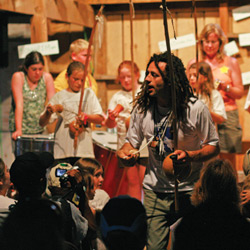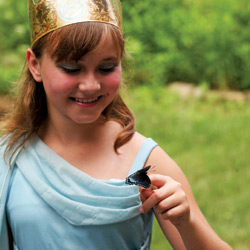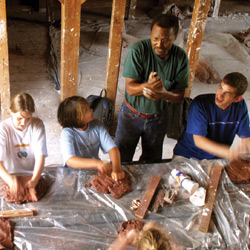The shock of witnessing the disappearance of green space and children’s
connections to nature sent Joan Root Ericksen and Bob Ericksen on a
mission they are still working on today.
Remember when roaming through a creek bed was one of the best things to do on a hot summer day? Remember finding all kinds of odd things that you’d make up names for because you didn’t know what they were? Imagine if you had been roaming that creek with someone who could teach you the name of everything you found and how it fit into the creek’s ecosystem—wouldn’t you have enjoyed that?
Did you ever spend days working with the paint left over from the school supplies you didn’t use during the year? Remember mixing different colors to see which new ones you could come up with? What if a professional artist had been there to show you how to use those colors to convey a mood or artistic vision?
Who knows—such opportunities might have even changed your career path. Perhaps today, you’d be standing near an easel or squatting at an archaeological dig. Fortunately, central Illinois has a place where our children can explore nature, science and the arts with professionals who can guide them in these various disciplines.
 In 1974, Joan Root Ericksen and Bob Ericksen offered the first taste of a revolutionary summer camp that would forever change the way our youth viewed the arts and sciences. Their idea was to bring students closer to nature, to experience the communion they both felt with their surroundings as children. And so, 35 years ago, on Joan’s family farm and a neighbor’s adjacent land, with 40 teachers and 450 students, Art & Science in the Woods came to life.
In 1974, Joan Root Ericksen and Bob Ericksen offered the first taste of a revolutionary summer camp that would forever change the way our youth viewed the arts and sciences. Their idea was to bring students closer to nature, to experience the communion they both felt with their surroundings as children. And so, 35 years ago, on Joan’s family farm and a neighbor’s adjacent land, with 40 teachers and 450 students, Art & Science in the Woods came to life.
For one week each summer, students are immersed in courses like Indian Classical Dance, Fossils and Rocks, Skateboard Graphic and Design, and CSI: Blue Heron Farm. With the opportunity to study alongside professionals, they gain a new appreciation for what it would be like to have a career in these fields.
Discovering the Need
The Ericksens grew up with deep connections to nature. Joan is originally from Roseland, Illinois, where she spent her early years exploring wild prairies, and Bob hails from Seattle, where he watched salmon spawn in his backyard. Yet even as a child, Joan recounted, she saw the importance that communities placed on green spaces was dwindling. Over time, they continued to see this decline more and more.
One of the most profound examples came when the Ericksens were teaching in the Chicago City College system. In this setting, they saw a very different type of childhood, as their students came from the steel mill areas and concrete communities of urban Chicago. “We saw that [they] had many challenges as a result of the environments they lived in, [and] the economic and educational resources they had available to them,” Joan explained.
Firm believers in the environment’s impact on a child’s growth, the Ericksens engaged their students in projects to design new play spaces for children in the city. They were soon asked to work with Urban Gateways, a program dedicated to exposing Chicago’s inner-city children to the arts, and went into elementary and high schools to continue the process of connecting students to nature.
Not only were children losing green space in urban settings, but also in areas that had been rural just years before. “We both went back to the communities we grew up in to work with young people and saw that the beautiful natural environment that nurtured us was not there for them,” reported Joan. “Their connection to nature was broken…We saw we had to do something bigger.” Ever since, the couple has tried to “make sure that children’s connection to nature is as whole as possible.”
A New Way to Learn
And that’s exactly what Art and Science in the Woods (ASIW) does. It gives students a chance to get away and fully immerse themselves in nature, art and science. According to Bob Ericksen, “We give them the tools…a really well-trained theater director…[or] a sculptor like Preston Jackson, and ask them to spend five days of fairly intense work, learning what it’s like to work as an artist. You work with clay or paint or metal, and it’s kind of demanding on the students because this is all new to them.” While demanding, the experience is extremely well received by both students and their parents.
This year, 13-year-old Haley of Germantown Hills will be attending her sixth ASIW camp, and like many others, she can’t get enough. “Art and Science in the Woods has definitely changed my outlook,” she said. “It shows us that arts and sciences aren’t confined to our original idea of labs, scientists, studios, etc.” She looks forward to the new courses offered each year. “Trying something new is always on the agenda!”
 Each student chooses one major and four different minors on which to focus during the week. They spend each morning in their major class and each afternoon on their minors, except on Friday, when they show the other students what they accomplished in their major class that week. At these Friday showcases, students are often inspired by something from another class, which then becomes their major the next year.
Each student chooses one major and four different minors on which to focus during the week. They spend each morning in their major class and each afternoon on their minors, except on Friday, when they show the other students what they accomplished in their major class that week. At these Friday showcases, students are often inspired by something from another class, which then becomes their major the next year.
After the students have shared their accomplishments with each other, their family and friends are welcomed to enjoy a picnic dinner and entertainment by the students in Chad Dunn’s Brazilian drumming class—a favorite year after year. Afterwards, the students are able to show off their exhibits and demonstrate what they have worked on throughout the week.
Mary and Andrew Muir’s three children, ages 11, 15 and 17, have attended ASIW for eight years. “Our children have been completely enriched by [ASIW], and the true beauty of the program is that they learn so much and have the time of their life doing it,” the Muirs reported. “They come home from the Sun Foundation every day—smiling, tired and happy—and can’t wait to tell us about rocket science, architecture or geology.” Friday’s open house allows Mary and Andrew to see what their children have been talking about all week.
A Place of Great Excitement
All of this takes place on Blue Heron Farm in Washburn, Illinois, where barns are converted into classrooms, forests are hiked, wetlands waded, prairies explored and tents rented to provide shelter from the hot sun and rain.
The Sun Foundation office is located in a geodesic dome, which was originally built as a prototype for a low-income housing project and once served as the Ericksens’ home. Classes are taught in a variety of locations, from the lower level of Joan and Bob’s current home on the property to their neighbors’ fossil beds and the marshes that comprise some of the most scientifically interesting property in central Illinois. The Crow Creek Marsh, for example, allows students to learn from hands-on experience. Haley raved about “this fossil class that lets us roam IN the creek…It gives us the chance to get wet and dirty while finding fossils!” she exclaimed.
Running the camp would be impossible without the support of local businesses and individuals who sponsor the program each year. With monetary or in-kind donations, they make it possible for the Sun Foundation to continue to offer its unique ways of teaching art and science to young people. More than 90 volunteers make enormous contributions as well, serving as teaching assistants and performing the behind-the-scenes operations necessary to keep the program running.
They Come to Learn
Art and Science in the Woods is a great experience for children and adults alike. Each class is geared toward a specific age group, with plenty of choices for everyone. Students (ages 6 to 18) are enrolled in classes with others of similar ages, while adults can learn just as much by serving as teaching assistants (TAs) or volunteers. Many of them gained so much from the program as students that they choose to give back as adults. “This is our 35th year, and it’s our third generation,” explained Joan. “We have teachers who are former students…and we have [former] students come back and bring their children and their grandchildren.”
 Trisha Noack’s three daughters attended ASIW when they were younger and have come back to serve as instructors and TAs. “It is an amazing experience to see how your children grow so much in just one week…They are exposed to so many exciting new ideas and people, in such a magnificent setting, that I believe it is a life-changing experience. It certainly has been for my three daughters, one of whom is returning for the third year to teach. The other two have returned year after year to be teaching assistants. Every year, the experience still has a profound effect on them.”
Trisha Noack’s three daughters attended ASIW when they were younger and have come back to serve as instructors and TAs. “It is an amazing experience to see how your children grow so much in just one week…They are exposed to so many exciting new ideas and people, in such a magnificent setting, that I believe it is a life-changing experience. It certainly has been for my three daughters, one of whom is returning for the third year to teach. The other two have returned year after year to be teaching assistants. Every year, the experience still has a profound effect on them.”
Sharon Obery has served as program coordinator for 12 years and has been involved with the program for 16 years. She began volunteering as a teaching assistant when her daughter was old enough to attend and enjoys spending time with “people who are enthusiastic and passionate about what they do.” Her daughter attended ASIW as a student for eight years and volunteered for five years after that. It seems that everyone involved gets more out of the experience with each passing year.
Imparting Knowledge
The 2009 program welcomes nearly 40 instructors, many of them ASIW veterans, across several disciplines, who give a week of their time each year to teach children about what they have dedicated their lives to. “[Putting] these kids into really close contact with working artists and scientists…becomes a kind of immersion program,” said Bob. “As we have recognized over the years, this will be their contact with an artist. Let’s do it right. Let’s have fun.”
And they sure do have fun! Every person I talked to raves about the program. “The thing I like best about the Sun Foundation is the freedom that they allow us,” reported Haley. “They let us express ourselves in ways we can’t do anywhere else. Basically, it’s like a break from summer vacation (with no work!). I love seeing all the unique instructors and their fields.”
Mary and Andrew Muir noted that the instructors teach students specific skills that they can implement in their own lives. “For example,” said Mary, “through their Aboriginal Survival course, [our children] learned how to respect the earth, and in their Ecology of Design course, they learned about the best ways to reduce their impact on the environment.”
The Foundation strives to make ASIW as convenient as possible for those who live in the surrounding communities. Because the campsite is located in Washburn—not exactly close to home for many families—bus transportation is available to and from camp. Students arrive at 9am each day, ready to explore and tackle what their instructors have prepared for them.
The Sun Foundation’s generous sponsors also make it possible for families who might not be able to afford the registration fee to send their children on scholarships—each year, they offer more than 100. “We really enjoy exposing kids to something that’s brand-new to them,” Bob said. “It’s something they need.”
Art and Science in the Woods provides children in central Illinois the opportunity to connect with nature and really dive deep into the realms of art and science. “Joan and Bob are two of the kindest, most intelligent and generous people we have the privilege of knowing,” said Mary and Andrew Muir. “The Sun Foundation is truly a gift they have given this community. We feel blessed to have participated in this program for so long. We hope that it goes on forever.” a&s
Art and Science in the Woods 2009
JUNE 8th TO 12th
9am to 3pm each day
Sun Foundation
1278 Sun Road
Washburn, IL 61570
SunFoundation.org
[email protected]
(309) 246-8403


